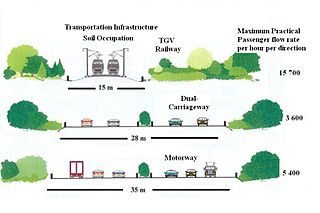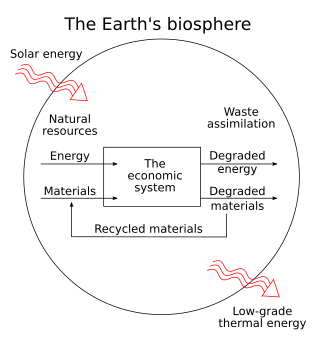Industrial ecology (IE) is the study of material and energy flows through industrial systems. The global industrial economy can be modelled as a network of industrial processes that extract resources from the Earth and transform those resources into by-products, products and services which can be bought and sold to meet the needs of humanity. Industrial ecology seeks to quantify the material flows and document the industrial processes that make modern society function. Industrial ecologists are often concerned with the impacts that industrial activities have on the environment, with use of the planet's supply of natural resources, and with problems of waste disposal. Industrial ecology is a young but growing multidisciplinary field of research which combines aspects of engineering, economics, sociology, toxicology and the natural sciences.

Sustainable urban infrastructure expands on the concept of urban infrastructure by adding the sustainability element with the expectation of improved and more resilient urban development. In the construction and physical and organizational structures that enable cities to function, sustainability also aims to meet the needs of the present generation without compromising the capabilities of the future generations.
Emergy is the amount of energy consumed in direct and indirect transformations to make a product or service. Emergy is a measure of quality differences between different forms of energy. Emergy is an expression of all the energy used in the work processes that generate a product or service in units of one type of energy. Emergy is measured in units of emjoules, a unit referring to the available energy consumed in transformations. Emergy accounts for different forms of energy and resources Each form is generated by transformation processes in nature and each has a different ability to support work in natural and in human systems. The recognition of these quality differences is a key concept.

Metabolic rift is a theory of ecological crisis tendencies under the capitalist mode of production that sociologist John Bellamy Foster ascribes to Karl Marx. Quoting Marx, Foster defines this as the "irreparable rift in the interdependent process of social metabolism". Foster argues that Marx theorized a rupture in the metabolic interaction between humanity and the rest of nature emanating from capitalist agricultural production and the growing division between town and country.
Environmental accounting is a subset of accounting proper, its target being to incorporate both economic and environmental information. It can be conducted at the corporate level or at the level of a national economy through the System of Integrated Environmental and Economic Accounting, a satellite system to the National Accounts of Countries.
The term anthroposystem is used to describe the anthropological analogue to the ecosystem. In other words, the anthroposystem model serves to compare the flow of materials through human systems to those in naturally occurring systems. As defined by Santos, an anthroposystem is "the orderly combination or arrangement of physical and biological environments for the purpose of maintaining human civilization...built by man to sustain his kind." The anthroposystem is intimately linked to economic and ecological systems as well.
Cleaner production is a preventive, company-specific environmental protection initiative. It is intended to minimize waste and emissions and maximize product output. By analysing the flow of materials and energy in a company, one tries to identify options to minimize waste and emissions out of industrial processes through source reduction strategies. Improvements of organisation and technology help to reduce or suggest better choices in use of materials and energy, and to avoid waste, waste water generation, and gaseous emissions, and also waste heat and noise.
Anthropogenic metabolism, also referred to as metabolism of the anthroposphere, is a term used in industrial ecology, material flow analysis, and waste management to describe the material and energy turnover of human society. It emerges from the application of systems thinking to the industrial and other man-made activities and it is a central concept of sustainable development. In modern societies, the bulk of anthropogenic (man-made) material flows is related to one of the following activities: sanitation, transportation, habitation, and communication, which were "of little metabolic significance in prehistoric times". Global man-made stocks of steel in buildings, infrastructure, and vehicles, for example, amount to about 25 Gigatonnes, a figure that is surpassed only by construction materials such as concrete. Sustainable development is closely linked to the design of a sustainable anthropogenic metabolism, which will entail substantial changes in the energy and material turnover of the different human activities. Anthropogenic metabolism can be seen as synonymous to social or socioeconomic metabolism. It comprises both industrial metabolism and urban metabolism.
Material flow analysis (MFA), also referred to as substance flow analysis (SFA), is an analytical method to quantify flows and stocks of materials or substances in a well-defined system. MFA is an important tool to study the bio-physical aspects of human activity on different spatial and temporal scales. It is considered a core method of industrial ecology or anthropogenic, urban, social and industrial metabolism. MFA is used to study material, substance, or product flows across different industrial sectors or within ecosystems. MFA can also be applied to a single industrial installation, for example, for tracking nutrient flows through a waste water treatment plant. When combined with an assessment of the costs associated with material flows this business-oriented application of MFA is called material flow cost accounting. MFA is an important tool to study the circular economy and to devise material flow management. Since the 1990s, the number of publications related to material flow analysis has grown steadily. Peer-reviewed journals that publish MFA-related work include the Journal of Industrial Ecology, Ecological Economics, Environmental Science and Technology, and Resources, Conservation, and Recycling.

Material flow management (MFM) is an economic focused method of analysis and reformation of goods production and subsequent waste through the lens of material flows, incorporating themes of sustainability and the theory of a circular economy. It is used in social, medical, and urban contexts. However, MFM has grown in the field of industrial ecology, combining both technical and economic approaches to minimize waste that impacts economic prosperity and the environment. It has been heavily utilized by the country of Germany, but it has been applied to the industries of various other countries. The material flow management process utilizes the Sankey Diagram, and echoes the circular economy model, while being represented in media environments as a business model which may help lower the costs of production and waste.
Material flow accounting (MFA) is the study of material flows on a national or regional scale. It is therefore sometimes also referred to as regional, national or economy-wide material flow analysis.
Industrial metabolism is a concept to describe the material and energy turnover of industrial systems. It was proposed by Robert Ayres in analogy to the biological metabolism as "the whole integrated collection of physical processes that convert raw materials and energy, plus labour, into finished products and wastes..." In analogy to the biological concept of metabolism, which is used to describe the whole of chemical reactions in, for example, a cell to maintain its functions and reproduce itself, the concept of industrial metabolism describes the chemical reactions, transport processes, and manufacturing activities in industry.

Ecological design or ecodesign is an approach to designing products and services that gives special consideration to the environmental impacts of a product over its entire lifecycle. Sim Van der Ryn and Stuart Cowan define it as "any form of design that minimizes environmentally destructive impacts by integrating itself with living processes." Ecological design can also be defined as the process of integrating environmental considerations into design and development with the aim of reducing environmental impacts of products through their life cycle.
The establishment of industrial ecology as field of scientific research is commonly attributed to an article devoted to industrial ecosystems, written by Frosch and Gallopoulos, which appeared in a 1989 special issue of Scientific American. Industrial ecology emerged from several earlier ideas and concepts, some of which date back to the 19th century.
This page is an index of sustainability articles.

Social metabolism or socioeconomic metabolism is the set of flows of materials and energy that occur between nature and society, between different societies, and within societies. These human-controlled material and energy flows are a basic feature of all societies but their magnitude and diversity largely depend on specific cultures, or sociometabolic regimes. Social or socioeconomic metabolism is also described as "the self-reproduction and evolution of the biophysical structures of human society. It comprises those biophysical transformation processes, distribution processes, and flows, which are controlled by humans for their purposes. The biophysical structures of society and socioeconomic metabolism together form the biophysical basis of society."
Eco-industrial development (EID) is a framework for industry to develop while reducing its impact on the environment. It uses a closed loop production cycle to tackle a broad set of environmental challenges such as soil and water pollution, desertification, species preservation, energy management, by-product synergy, resource efficiency, air quality, etc.
MuSIASEM or Multi-Scale Integrated Analysis of Societal and Ecosystem Metabolism, is a method of accounting used to analyse socio-ecosystems and to simulate possible patterns of development. It is based on maintaining coherence across scales and different dimensions of quantitative assessments generated using different metrics.
A circular economy is an alternative way countries manage their resources, in which usage of products in the traditional linear make, use, and dispose method is not implemented. Instead, resources are used for their maximum utility throughout their life cycle and regenerated in a cyclical pattern minimizing waste. They strive to create economic development through environmental and resource protection. The ideas of a circular economy were officially adopted by China in 2002, when the 16th National Congress of the Chinese Communist Party legislated it as a national endeavor though the various sustainability initiatives which were implemented in the previous decades starting in 1973. China adopted the circular economy due to the environmental damage and resource depletion that was occurring from going through its industrialization process. China is currently a world leader in the production of resources, where it produces 46% of the world's aluminum, 50% of steel and 60% of cement, while it has consumed more raw materials than all the countries a part of the Organisation for Economic Co-operation and Development (OECD) combined. In 2014, China created 3.2 billion tonnes of industrial solid waste, where 2 billion tonnes were recovered using recycling, incineration, reusing and composting. By 2025, China is anticipated to produce up to one quarter of the world's municipal solid waste.
Stephanie Pincetl is an American academic specializing in the intersection of urban policy and the environment, particularly in California. She is the Director of the UCLA Center for Sustainable Urban Systems in Los Angeles.









